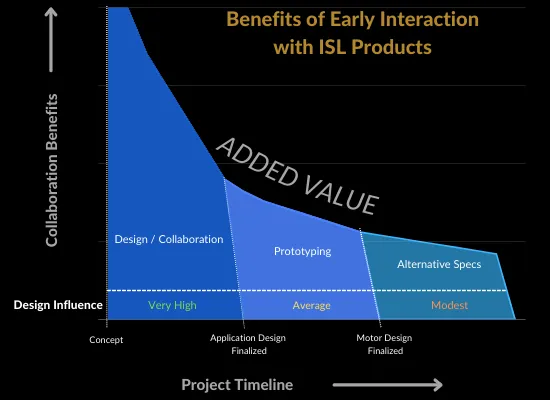Enhancing the Motor Selection Process
At any stage throughout your DC motor selection process, our team of dedicated engineers will collaborate with you to ensure that we provide the optimal motor solution. Early engagement with an ISL Products’ Applications Engineer has been proven to save engineers valuable time throughout the entire motor selection process. When your application or device requires a DC motor or gear motor, contact an ISL applications engineer!
Get Started Now: Input Your Motor Specs or View the ISL Motor Database
Your timeline and expectations are very important to us. The first step our application engineer will take is to learn about your project’s timeline ensuring all items are delivered in a timely manner. On average, engineers save over 10 hours of research time during their motor selection process by speaking with an ISL apps engineer. Get started by submitting some preliminary specs via our quick 3-Step Motor Selection Guide.

Start the Discussion with an Applications Engineer
An application engineer will ask some preliminary questions to learn more about your application and motor requirements in order to provide the optimal motor solution. Some common questions they may ask you early in the design process are:
- What type of motor are you interested in, brushed, brushless (BLDC), stepper, etc.?
- Are you considering a gear motor for additional torque output?
- Do you have any preliminary application data that may benefit us in the motor selection process?
- What are some of the more critical motor parameters that we should be aware of?
Once a these questions are answered, the applications engineer will analyze your requirements and provide a preliminary motor solution.
Preliminary Design Specifications
Our preliminary design specifications will include an overall dimensional drawing and motor performance curves. Our proprietary motor simulation software allows us to provide projected performance data very early on in the motor selection process, even before a sample is made.
Our motor / gear motor design database helps our application engineers streamline the selection process even further. They have the ability to cross-reference your requirements to pre-existing designs, making the design process much quicker. If slight alterations are needed to meet your specific requirements they will make those adjustments.
Parameters to Consider During Motor Selection
Torque & Speed
The two most important parameters when selecting a motor are the torque and speed. More specifically, the torque and speed you would like the motor to operate at under the anticipated load. The option of adding a gear head to the motor will significantly increase the torque available but reduce the speed.
Voltage & Current Draw
When dealing with any DC powered device, understanding the available voltage is important. The voltage will dictate a lot about a motor’s internal design characteristics. Once the voltage is determined, another parameter to consider is the current draw. Current draw becomes a more important factor if the device is battery powered. If you’re using a constant DC power source, the current draw may not be as critical. Understanding these electrical parameters helps the applications engineer get a feel for the overall power available.
Understanding the Data
It’s very important that you understand the data that we provide as well as your application’s requirements. All of these are crucial in the design and performance of your application or device. Our apps engineers will help to educate you and answer any questions throughout the entire process.
Application Requirements & Design Considerations
Providing application duty cycle information to an apps engineer will give ample insight on how the motor will be expected to perform. When discussing duty cycle, you should mention if the motor will be running continuously or intermittently. If a duty cycle is intermittent, how long will it operate (ON time) and what is the rest period in between (OFF time)? Will the motor be changing rotational direction? If so, make sure there is enough dwell time in between changes in direction.
With the use of our in-house motor test equipment we are able to accurately simulate your expected duty cycle and provide useful insight on how our motor will perform. Our equipment also allows us to generate performance curves illustrating the speed, torque, current draw and power of a motor from no-load to stall. All of these figures can be signed off on before moving onto mass production, ensuring you get exactly what you need.
Dedicated Service After The Selection Process
Even after the motor selection process is complete, our dedicated team of application engineers are here to assist. Our post-production quality testing ensures our motors meet or exceed your expectations before the motors arrive at your facility.
Our goal is to make the overall motor selection process quick and exciting for you and your team. We are able to accomplish this by providing valuable insight from many years of experience and by serving as an extension of your engineering team. Get started, reach out to an Applications Engineer today!


